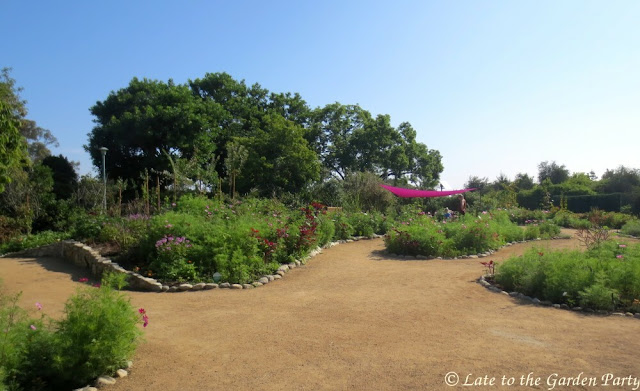My garden has slid into the summer doldrums and the pickings for IAVOM are currently slim. The dahlias have been slow to bloom. Only two of mine have well-developed buds. Five or six others appear to be developing buds. The rest are healthy and getting larger by the day but they're certainly taking they're their time to produce flowers. The first zinnias are blooming but I can't say they're putting on a good show yet either.
The plants making the biggest floral splash in my garden right now are the Leonotis leonurus (aka lion's tail). I improvised a bit to come up with suitable companions.
 |
| I added a couple of orange Zinnias and Alstroemeria 'Indian Summer' to play off the color of the Leonotis |
 |
| Back view: The spiky green stems that look a little like Cyperus grass (papyrus) are Agapanthus stems stripped of their spent flowers to add a little height to the arrangement |
Although most of my Agapanthus are scruffy, I found a few presentable enough to be included in a second arrangement. I scraped together some other flowers among those I'm ready to retire for the season to accompany the Agapanthus.
 |
| Front and center is Agapanthus 'Twister', as well as a bi-color Eustoma grandiflorum (aka lisianthus). I've had a few blooms of Eustoma this year but they've been very disappointing overall. |
 |
| Back view: I added the last of the peach foxgloves and one white foxglove stem to the arrangement, using stems of Viola 'Penny Peach' to the mix to knit the various colors together |
 |
| The overhead view of the arrangement is my favorite |
There were two presentable lilies left in my back garden so I popped those into a small vase for the kitchen island.
 |
| The vase contains the last 2 blooms of Lilium 'Pretty Woman', Alstroemeria 'Inca Vienna', and white Eustoma grandiflorum |
Our temperatures have fallen since Thursday last week. Our marine layer didn't lift until almost 2pm yesterday. Our afternoon high didn't climb above 82F/27C either and I'm hoping that trend continues. If I'm going to clear out all those the scruffy Agapanthus and other spent summer flowers, I need a stretch of cooler weather to get the job done.
For more IAVOM creations, visit Cathy at Rambling in the Garden.
All material © 2012-2023 by Kris Peterson for Late to the Garden Party


























































